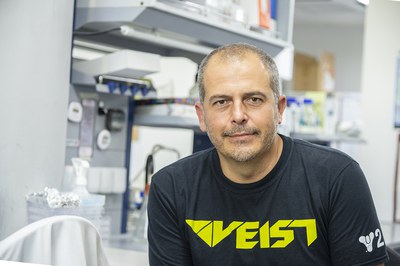Associate Investigator
Head of High Content Screen Facility
Other positions:
Associate Professor of Biology, Department of Translational Medicine, University of Naples “Federico II”, Italy
Diego L. Medina obtained his PhD in Biochemistry and Molecular Biology in 2000, at the UAM/CSIC of Madrid, Spain. Since 2011, Prof Medina has held positions as Assistant Investigator and Head of the High Content Screening Facility at the Telethon Institute of Genetics and Medicine (TIGEM). Since April 2019, he has also held a position at the University of Naples “Federico II” as Associate Professor in Biology at the Medical Genetics Unit, Department of Medical and Translational Science. Prof. Medina’s research group focuses on the study of the fundamental biological role of lysosomal function in health and disease using state-of-the-art high content imaging (HCI), cell biology, and OMICs approaches. Information from basic research is then exploited for the development of new therapeutic strategies to treat rare genetic diseases. Medina has published 57 articles in peer-review international journals. His work is supported by many funding sources including the Horizon 2020 proposal (of which he is WP leader) and the Italian Telethon Foundation. He also receives support from a number of foundations which focus on specific diseases including the ML4 Foundation, CTF&CATS Foundation, Cure San Filippo Foundation, and MDBR grant program.
Lysosomal calcium signalling and autophagy
Repurposing approach to cure lysosomal storage disorders
We contributed to the discovery that TFEB over-expression can promote cellular clearance in different lysosomal storage disorders (LSDs) by inducing lysosomal exocytosis, a process that requires TRPML1-dependent Ca2+ release (Medina DL, et al, 2011). This seminal finding was subsequently independently confirmed by many other labs, suggesting that either TRPML1 or TFEB may represent novel therapeutic targets for the identification of compounds modulating its clearance activity. Over the last few years, we have developed cell-based high content imaging screening approaches to identify compounds able to induce the TFEB pathway in cellular models of LSDs. In particular, we have focused on the repurposing of FDA-approved drugs to tackle Batten Diseases, Mucopolysaccharidosis and Mucolipidosis type IV. The identification of FDA drugs correcting LSDs may significantly reduce the costs and time associated with clinical translation.
- Fluoxetine ameliorates mucopolysaccharidosis type IIIA. Molecular Therapy, 2022
- Repurposing of tamoxifen ameliorates CLN3 and CLN7 disease phenotype. EMBO Molecular Medicine, 2021
- TRPML1 links lysosomal calcium to autophagosome biogenesis through the activation of the CaMKKβ/VPS34 pathway. Nature Communications, 2019
- Lysosomal calcium signalling regulates autophagy through calcineurin and TFEB. Nature Cell Biology, 2015
- Transcriptional activation of lysosomal exocytosis promotes cellular clearance. Developmental Cell, 2011
Complete List of Published Work here
Quote
My research goal is to gain insight into the cell biology of the lysosomal and autophagic pathways, which can inform translational studies that will be instrumental in the development of new therapies to tackle rare genetic diseases.
Additional Funding
- ODC - THE ORPHAN DISEASE CENTER - Characterization of the kidney pathology in Mucolipidosis type IV (2023-2024)










